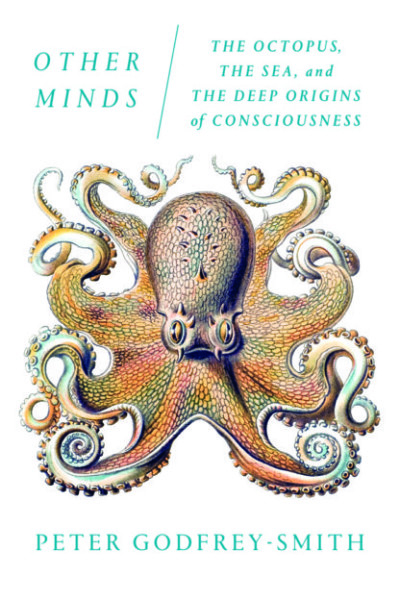Review: Peter Godfrey-Smith’s “Other Minds”
by Miles Raymer
As humanity finally learns (or is forced) to confront the reality and imminent dangers of climate change, we’re going to need every bit of mental flexibility and creativity we can muster. There has probably never been a moment in history when it was more critical for us to explore and appreciate types of intelligence different from our own. If for no other reason, this makes Peter Godfrey-Smith’s Other Minds a text worthy of attention. In this examination of the origins and character of cephalopod intelligence, Godfrey-Smith gives readers an opportunity not only to encounter a radically different kind of mind, but also to reflect on the intricacy and limitations of our own cognition. This is a great complement to one of my favorite books of 2016: Frans de Waal’s Are We Smart Enough to Know How Smart Animals Are?
Although I enjoyed this book overall, I wish I had read Other Minds about a decade ago. Godfrey-Smith does a good job of providing the necessary context for discussions about the biological origins of life, intelligence and consciousness, and effectually brings his philosophical training to the table. But, unfortunately for me, I’ve studied these areas quite a lot already; too often I found my mind wandering due to over-familiarity with large chunks of the subject matter.
Happily, I’m not at all educated about the delightful cephalopods with which Godfrey-Smith is so smitten. Reading about the lives of these sea-dwellers––squid, cuttlefish, octopus, nautilus––captivated my imagination and unlocked yet another vein of gratitude for Earth’s cornucopia of life.
Godfrey-Smith frames humanity’s study of cephalopods as “probably the closest we will come to meeting an intelligent alien” (9). This is primarily because the last common ancestor shared by both humans and cephalopods is much, much further in the past than that of any other nonhuman animals we consider intelligent. Godfrey-Smith makes a strong case for the radical otherness of cephalopods, but also points out toward the end of the book that “it’s [the octopus] not really an alien; the Earth and its oceans made us both” (200). This tension between terrestrial familiarity and biological/behavioral alterity is what makes Other Minds an engaging read.
Cephalopods––and octopuses primarily––possess some extremely unique characteristics, including almost limitless flexibility, distributed nervous systems, and skin that changes color with perplexing celerity and attitude. This “body of pure possibility,” as Godfrey-Smith puts it, “makes it clear the way they have become smart animals. They are smart in the sense of being curious and flexible; they are adventurous, opportunistic” (48, 64, emphasis his). Above all, I think it is this quality that makes the octopus a deserving recipient of our respect and affection.
Although the chapter on cephalopod color-making is fascinating, the highlight for me is Godfrey-Smith’s descriptions of how their nervous systems are structured. Unlike humans, cephalopods do not have a single location we can point to and say, Ah, now here’s where the lion’s share of cognition and executive control are located. Instead,
A different body plan evolved, and a different kind of nervous system. These nervous systems are more distributed, less centralized, than ours. Invertebrates’ neurons are often collected into many ganglia, little knots that are spread through the body and connected to each other. The ganglia can be arranged in pairs, linked by connectors that run along the body and across it, like lines of latitude and longitude. This is sometimes called a “ladder-like” nervous system, and it does look like a ladder embedded within the body. The ancestral cephalopods probably had nervous systems something like this, so when evolution multiplied their neurons, the multiplication took place on this design.
In that expansion, some ganglia became large and complex, and new ones were added. Neurons concentrated at the front of the animal, forming something more and more like a definite brain. The old ladder-like designed was partly submerged, but only partly, and the underlying architecture of cephalopod nervous systems remain quite different from our own. (66, emphasis his)
Research indicates that cephalopod limbs have considerable autonomy compared to the limbs of mammals, although the degree to which this is true is imperfectly understood. Godfrey-Smith believes that a “mixture of localized and top-down control might be operating” (68). While this is also true of humans and other nonhuman animals to some degree, it seems a fair assumption that our cephalopod friends are far less cognitively “united” than we are. This makes it extremely difficult to imagine what an octopus’s experience might be like; we can’t even be sure if its experience is centralized enough to constitute a subjectivity that can “feel” anything at all. For a harrowing and brilliant fictionalized exploration of how distributed nervous systems might operate in highly intelligent yet non-conscious entities, I recommend Peter Watts’s Blindsight.
I think we can learn an important lesson from cephalopod anatomy. This lesson doesn’t pertain to us as discrete individuals, but rather to our collective endeavors. Time and again we find that organizations––businesses, governments, charities, churches, armies, etc.––suffer when they fail to achieve a balance between top-down and bottom-up pressures. Too much control concentrated at the top tends to alienate and disempower the majority of participants, whereas too little centralized organization tends to make organizations grossly inefficient. I think everyone would benefit from remembering the noble octopus when trying to analyze and overcome this persistent challenge.
Though it contains a lot of interesting information and insight, Other Minds left me unsatisfied. This is no fault of Godfrey-Smith’s; the problem is intrinsic to inquiries that bring us to the very edge of human knowledge. Despite our best efforts to understand cephalopods, the only clear message I took away is that we know hardly anything about what’s really going on with these wacky critters––at least for now! And while I welcome an opportunity to acknowledge nature’s grand mysteries, I’d hoped for something more concrete than the measured speculations Godfrey-Smith was able to provide.
Rating: 7/10
